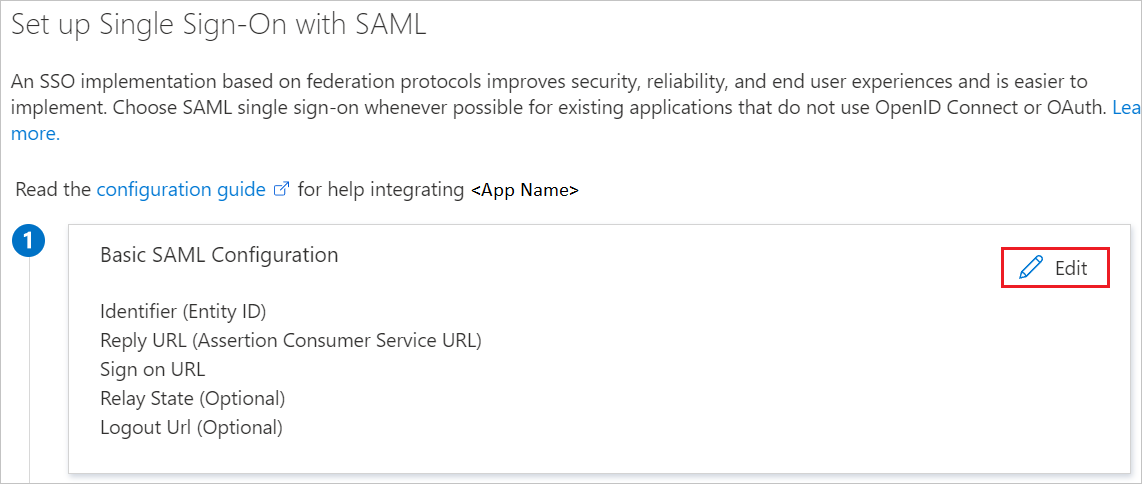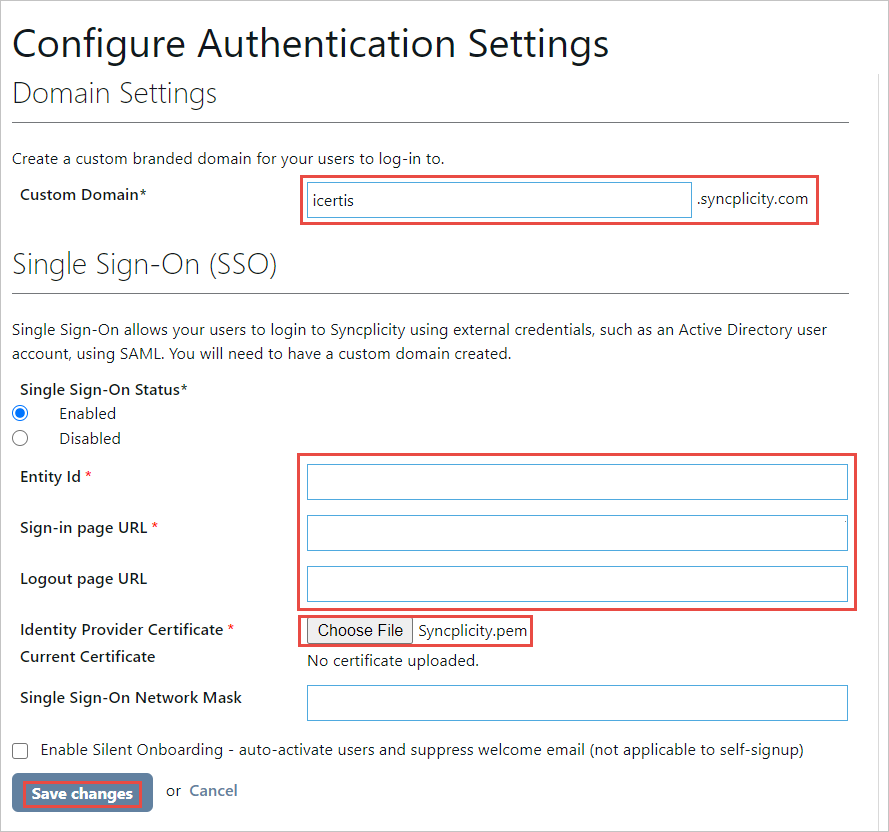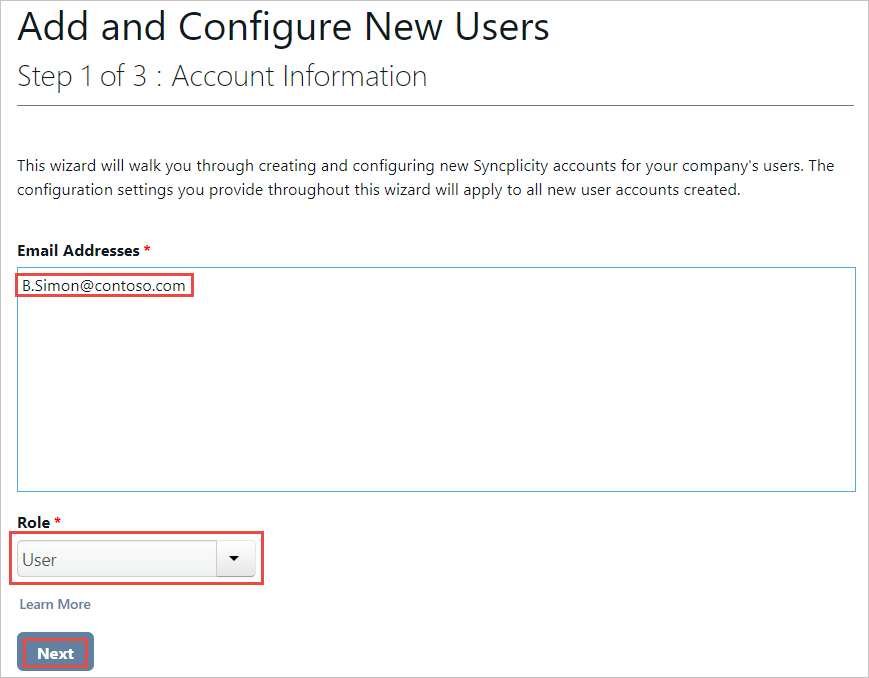Integrate Syncplicity with Microsoft Entra ID
In this article, you'll learn how to integrate Syncplicity with Microsoft Entra ID. When you integrate Syncplicity with Microsoft Entra ID, you can:
- Control in Microsoft Entra ID who has access to Syncplicity.
- Enable your users to be automatically signed-in to Syncplicity with their Microsoft Entra accounts.
- Manage your accounts in one central location.
Prerequisites
To get started, you need the following items:
- A Microsoft Entra subscription. If you don't have a subscription, you can get a free account.
- Syncplicity single sign-on (SSO) enabled subscription.
Scenario description
In this article, you configure and test Microsoft Entra SSO in a test environment.
- Syncplicity supports SP initiated SSO.
Add Syncplicity from the gallery
To configure the integration of Syncplicity into Microsoft Entra ID, you need to add Syncplicity from the gallery to your list of managed SaaS apps.
- Sign in to the Microsoft Entra admin center as at least a Cloud Application Administrator.
- Browse to Identity > Applications > Enterprise applications > New application.
- In the Browse Microsoft Entra gallery section, type Syncplicity in the search box.
- Select Syncplicity from results panel and then click Create to add the app. Wait a few seconds while the app is added to your tenant.
Alternatively, you can also use the Enterprise App Configuration Wizard. In this wizard, you can add an application to your tenant, add users/groups to the app, assign roles, as well as walk through the SSO configuration as well. Learn more about Microsoft 365 wizards.
Configure and test Microsoft Entra SSO for Syncplicity
Configure and test Microsoft Entra SSO with Syncplicity using a test user called B.Simon. For SSO to work, you need to establish a link relationship between a Microsoft Entra user and the related user in Syncplicity.
To configure and test Microsoft Entra SSO with Syncplicity, perform the following steps:
- Configure Microsoft Entra SSO - to enable your users to use this feature.
- Create a Microsoft Entra test user - to test Microsoft Entra single sign-on with B.Simon.
- Assign the Microsoft Entra test user - to enable B.Simon to use Microsoft Entra single sign-on.
- Configure Syncplicity SSO - to configure the single sign-on settings on application side.
- Create Syncplicity test user - to have a counterpart of B.Simon in Syncplicity that is linked to the Microsoft Entra representation of user.
- Test SSO - to verify whether the configuration works.
- Update SSO - to make the necessary changes in Syncplicity if you have changed the SSO settings in Microsoft Entra ID.
Configure Microsoft Entra SSO
Follow these steps to enable Microsoft Entra SSO.
Sign in to the Microsoft Entra admin center as at least a Cloud Application Administrator.
Browse to Identity > Applications > Enterprise applications > Syncplicity > Single sign-on.
On the Select a single sign-on method page, select SAML.
On the Set up single sign-on with SAML page, click the pencil icon for Basic SAML Configuration to edit the settings.

In the Basic SAML Configuration section, perform the following steps:
a. In the Identifier (Entity ID) text box, type a URL using the following pattern:
https://<COMPANY_NAME>.syncplicity.com/spb. In the Sign on URL text box, type a URL using the following pattern:
https://<COMPANY_NAME>.syncplicity.comc. In the Reply URL (Assertion Consumer Service URL) text box, type a URL using the following pattern:
https://<COMPANY_NAME>.syncplicity.com/Auth/AssertionConsumerService.aspxNote
These values are not real. Update these values with the actual Reply URL,Sign on URL and Identifier. Contact Syncplicity Client support team to get these values. You can also refer to the patterns shown in the Basic SAML Configuration section.
On the Set up Single Sign-On with SAML page, in the SAML Signing Certificate section, click Edit. Then in the dialog click the ellipsis button next to your active certificate and select PEM certificate download.

Note
You need the PEM certificate, as Syncplicity does not accept certificates in CER format.
On the Set up Syncplicity section, copy the appropriate URL(s) based on your requirement.

Create a Microsoft Entra test user
In this section, you'll create a test user called B.Simon.
- Sign in to the Microsoft Entra admin center as at least a User Administrator.
- Browse to Identity > Users > All users.
- Select New user > Create new user, at the top of the screen.
- In the User properties, follow these steps:
- In the Display name field, enter
B.Simon. - In the User principal name field, enter the username@companydomain.extension. For example,
B.Simon@contoso.com. - Select the Show password check box, and then write down the value that's displayed in the Password box.
- Select Review + create.
- In the Display name field, enter
- Select Create.
Assign the Microsoft Entra test user
In this section, you'll enable B.Simon to use single sign-on by granting access to Syncplicity.
- Sign in to the Microsoft Entra admin center as at least a Cloud Application Administrator.
- Browse to Identity > Applications > Enterprise applications > Syncplicity.
- In the app's overview page, select Users and groups.
- Select Add user/group, then select Users and groups in the Add Assignment dialog.
- In the Users and groups dialog, select B.Simon from the Users list, then click the Select button at the bottom of the screen.
- If you are expecting a role to be assigned to the users, you can select it from the Select a role dropdown. If no role has been set up for this app, you see "Default Access" role selected.
- In the Add Assignment dialog, click the Assign button.
Configure Syncplicity SSO
Sign in to your Syncplicity tenant.
In the menu on the top, click Admin, select Settings, and then click Custom domain and single sign-on.

On the Single Sign-On (SSO) dialog page, perform the following steps:

a. In the Custom Domain textbox, type the name of your domain.
b. Select Enabled as Single Sign-On Status.
c. In the Entity Id textbox, Paste the Identifier (Entity ID) value, which you have used in the Basic SAML Configuration.
d. In the Sign-in page URL textbox, Paste the Sign on URL which you copied previously.
e. In the Logout page URL textbox, Paste the Logout URL which you copied previously.
f. In Identity Provider Certificate, click Choose file, and then upload the certificate which you have downloaded.
g. Click SAVE CHANGES.
Create Syncplicity test user
For Microsoft Entra users to be able to sign in, they must be provisioned to Syncplicity application. This section describes how to create Microsoft Entra user accounts in Syncplicity.
To provision a user account to Syncplicity, perform the following steps:
Sign in to your Syncplicity tenant (for example:
https://company.Syncplicity.com).Click Admin and select User Accounts, then click Add a User.

Type the Email addresses of a Microsoft Entra account you want to provision, select User as Role, and then click Next.

Note
The Microsoft Entra account holder gets an email including a link to confirm and activate the account.
Select a group in your company that your new user should become a member of, and then click Next.

Note
If there are no groups listed, click Next.
Select the folders you would like to place under Syncplicity’s control on the user’s computer, and then click Next.

Note
You can use any other Syncplicity user account creation tools or APIs provided by Syncplicity to provision Microsoft Entra user accounts.
Test SSO
In this section, you test your Microsoft Entra single sign-on configuration with following options.
Click on Test this application, this will redirect to Syncplicity Sign-on URL where you can initiate the login flow.
Go to Syncplicity Sign-on URL directly and initiate the login flow from there.
You can use Microsoft My Apps. When you click the Syncplicity tile in the My Apps, this will redirect to Syncplicity Sign-on URL. For more information about the My Apps, see Introduction to the My Apps.
Update SSO
Whenever you need to make changes to the SSO, you need to check the SAML Signing Certificate being used. If the certificate has changed, make sure to upload the new one to Syncplicity as described in Configure Syncplicity SSO.
If you are using the Syncplicity Mobile app, please contact the Syncplicity Customer Support (support@syncplicity.com) for assistance.
Related content
Once you configure Syncplicity you can enforce session control, which protects exfiltration and infiltration of your organization’s sensitive data in real time. Session control extends from Conditional Access. Learn how to enforce session control with Microsoft Defender for Cloud Apps.